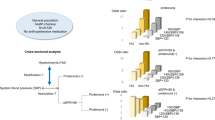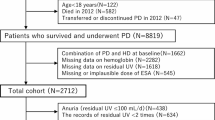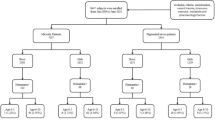Abstract
Background
We sought to evaluate renal stiffness in children with hematuria and/or proteinuria using shear wave elastography (SWE) and to investigate the clinical value of renal stiffness in children with hematuria and/or proteinuria.
Methods
According to the results of urinary occult blood and urinary protein tests, 349 pediatric patients were categorized into one of four groups: pure hematuria (HU), pure proteinuria (PU), concomitant hematuria and proteinuria (HUPU), or control (non-HUPU). Patient demographic data, laboratory test results, and renal ultrasound data were collected.
Results
There were significant differences in cortical/medullary elasticity among the four groups (the most sensitive cutoff value between HU and PU was 1.72) (P < 0.05). We found that hematuria and proteinuria interacted with renal cortical elasticity (P < 0.05) but that hematuria and proteinuria did not interact with renal medullary elasticity or cortical/medullary elasticity (P > 0.05). Renal elasticity values correlated with sex, age, body surface area, body mass index, qualitative urinary protein, urine N-acetyl-β-D-glucosaminidase, 24-hour urinary protein quantity, renal volume, and renal cortical thickness (P < 0.05).
Conclusions
SWE can be used to detect changes in renal stiffness in children with hematuria and/or proteinuria. SWE is beneficial for the early detection of glomerular disease in children with abnormal urine test results.
Impact
-
This study evaluated the utility of shear wave elastography for the assessment of renal elasticity in pediatric patients presenting with hematuria and/or proteinuria.
-
Children with pure proteinuria had significantly higher renal cortical/medullary elasticity values than those with pure hematuria.
-
An interaction effect between hematuria and proteinuria on renal cortical stiffness was observed.
-
Shear wave elastography can be used as a tool to assess early renal injury in children with urinalysis abnormalities.
This is a preview of subscription content, access via your institution
Access options
Subscribe to this journal
Receive 14 print issues and online access
$259.00 per year
only $18.50 per issue
Buy this article
- Purchase on SpringerLink
- Instant access to full article PDF
Prices may be subject to local taxes which are calculated during checkout




Similar content being viewed by others
Data availability
The datasets generated during and/or analyzed during the current study are available from the corresponding author upon reasonable request.
References
Yamagata, K., Takahashi, H., Tomida, C., Yamagata, Y. & Koyama, A. Prognosis of asymptomatic hematuria and/or proteinuria in men - high prevalence of iga nephropathy among proteinuric patients found in mass screening. Nephron 91, 34–42 (2002).
Coca, S. G. et al. Preoperative proteinuria predicts acute kidney injury in patients undergoing cardiac surgery. J. Thorac. Cardiovasc. Surg. 143, 495–502 (2012).
Tracz, M. J., Alam, J. & Nath, K. A. Physiology and pathophysiology of heme: implications for kidney disease. J. Am. Soc. Nephrol. 18, 414–420 (2007).
Huerta-Alardin, A. L., Varon, J. & Marik, P. E. Bench-to-bedside review: rhabdomyolysis - an overview for clinicians. Crit. Care 9, 158–169 (2005).
Fathallah-Shaykh, S. A. Proteinuria and progression of pediatric chronic kidney disease: lessons from recent clinical studies. Pediatr. Nephrol. 32, 743–751 (2017).
Abbate, M., Zoja, C. & Remuzzi, G. How does proteinuria cause progressive renal damage? J. Am. Soc. Nephrol. 17, 2974–2984 (2006).
Fogo, A. B. Mechanisms of progression of chronic kidney disease. Pediatr. Nephrol. 22, 2011–2022 (2007).
Hu, J. Y. et al. Relation between proteinuria and acute kidney injury in patients with severe burns. Crit. Care 16, R172 (2012).
Han, S. S. et al. Proteinuria and hematuria are associated with acute kidney injury and mortality in critically Ill patients: a retrospective observational study. Bmc Nephrol. 15, 93 (2014).
Schwartz et al. New equations to estimate gfr in children with Ckd. J. Am. Soc. Nephrol. 20, 629–637 (2009).
Makita, A. et al. The association between renal elasticity evaluated by real-time tissue elastography and renal fibrosis. Clin. Exp. Nephrol. 25, 981–987 (2021).
Liu, Q. & Wang, Z. R. Diagnostic value of real-time shear wave elastography in children with chronic kidney disease. Clin. Hemorheol. Micro 77, 287–293 (2021).
Wu, Y. et al. The association of hematuria on kidney clinicopathologic features and renal outcome in patients with diabetic nephropathy: a biopsy-based study. J. Endocrinol. Invest 43, 1213–1220 (2020).
Kramer, A. B. et al. Modulation of osteopontin in proteinuria-induced renal interstitial fibrosis. J. Pathol. 207, 483–492 (2005).
Zhen, A. et al. Clinicopathologic features of IgA nephropathy patients with different levels of proteinuria. Clin. Nephrol. 86, 35–41 (2016).
Fan, S.-m et al. Establishing an appropriate Z score regression equation for chinese pediatric coronary artery echocardiography: a multicenter prospective cohort study. BMC Pediatr. 21, 429 (2021).
Iyengar, A. et al. Are low birth weight neonates at risk for suboptimal renal growth and function during infancy? BMC Nephrol. 17, 100 (2016).
Zhu, M. Y. et al. Elastography ultrasound with machine learning improves the diagnostic performance of traditional ultrasound in predicting kidney fibrosis. J. Formos. Med Assoc. 121, 1062–1072 (2022).
Gunduz, N., Buz, A. & Kabaalioglu, A. Does early diabetic kidney damage alter renal elasticity? An ultrasound-based, two-dimensional shear wave elastography study. Medeni. Med J. 36, 209–216 (2021).
Hothan, K. A. et al. Prevalence of hypertension, obesity, hematuria and proteinuria amongst healthy adolescents living in Western Saudi Arabia. Saudi Med J. 37, 1120–1126 (2016).
Toda, A., Hara, S., Tsuji, H. & Arase, Y. Effects of body weight change on development of chronic kidney disease in obese metabolic phenotypes. Nephron 146, 449–456 (2022).
Clark, M., Aronoff, S. & Del Vecchio, M. Etiologies of asymptomatic microscopic hematuria in children—systematic review of 1092 subjects. Diagnosis 2, 211–216 (2015).
Zhang, S. et al. Identification and characterization of ovarian cancer-initiating cells from primary human tumors. Cancer Res. 68, 4311–4320 (2008).
Sumbul, H. E., Koc, A. S. & Gulumsek, E. Renal cortical stiffness is markedly increased in pre-diabetes mellitus and associated with albuminuria. Singapore Med J. 61, 435–442 (2020).
Lin, H. Y. H. et al. Association of renal elasticity and renal function progression in patients with chronic kidney disease evaluated by real-time ultrasound elastography. Sci. Rep-Uk 7, 43303 (2017).
Gao, J. et al. Corticomedullary strain ratio: a quantitative marker for assessment of renal allograft cortical fibrosis. J. Ultrasound Med 32, 1769–1775 (2013).
Zhai, Y. et al. Renal histological features of school-age children with asymptomatic haematuria and/or proteinuria: a multicenter study. Nephrology (Carlton) 19, 426–431 (2014).
Campanholle, G., Ligresti, G., Gharib, S. A. & Duffield, J. S. Cellular mechanisms of tissue fibrosis. 3. Novel mechanisms of kidney fibrosis. Am. J. Physiol. Cell Physiol. 304, C591–C603 (2013).
Liu, Y. H. Cellular and molecular mechanisms of renal fibrosis. Nat. Rev. Nephrol. 7, 684–696 (2011).
Xu, Q. C. et al. Alteration in shear wave elastography is associated with acute kidney injury: a prospective observational pilot study. Shock 59, 375–384 (2023).
Chen, Z. M., Chen, J. X., Chen, H. & Su, Z. Z. Evaluation of renal fibrosis in patients with chronic kidney disease by shear wave elastography: a comparative analysis with pathological findings. Abdom. Radio. 47, 738–745 (2022).
Hu, Q. et al. Acoustic radiation force impulse imaging for non-invasive assessment of renal histopathology in chronic kidney disease. Plos One 9, e115051 (2014).
van den Belt, S. M. et al. Early proteinuria lowering by angiotensin-converting enzyme inhibition predicts renal survival in children with Ckd. J. Am. Soc. Nephrol. 29, 2225–2233 (2018).
Correia-Costa, L., Azevedo, A. & Afonso, A. C. Childhood obesity and impact on the kidney. Nephron 143, 8–11 (2019).
Singh, H., Panta, O. B., Khanal, U. & Ghimire, R. K. Renal cortical elastography: normal values and variations. J. Med. Ultrasound 25, 215–220 (2017).
Lee, A. et al. Renal tissue elasticity by acoustic radiation force impulse a prospective study of healthy kidney donors. Medicine 100, e23561 (2021).
Jarv, L. et al. Ultrasound elastography correlations between anthropometrical parameters in kidney transplant recipients. J. Invest Med 67, 1137–1141 (2019).
Early, H., Aguilera, J., Cheang, E. & McGahan, J. Challenges and considerations when using shear wave elastography to evaluate the transplanted kidney, with pictorial review. J. Ultras Med. 36, 1771–1782 (2017).
Acknowledgements
The authors are grateful to all staff members, doctors, and statistical consultants who were involved in this study.
Funding
This research was supported by the Wenzhou Science & Technology Bureau (Project No. Y20210223), and the Huadong Medicine Joint Funds of the Zhejiang Provincial Natural Science Foundation of China (Grant No. LHDMY24H280003).
Author information
Authors and Affiliations
Contributions
C.Z. and L.W. designed the study and M.X. collected and analysed the study data. X.L. and P.C. supervised the data collection and the conduct of the study. Y.L. and Xiaoying Cui provided statistical advice on study design and data collection. Xingyu Chen and X.H. wrote the original draft. All authors reviewed and edited. C.Z. takes responsibility for the paper as a whole.
Corresponding authors
Ethics declarations
Competing interests
The authors declare no competing interests.
Ethics approval
This study was approved by the Medical Ethics Committee of The Second Affiliated Hospital and Yuying Children’s Hospital of Wenzhou Medical University (Approval No.: 2022-K-314-02).
Additional information
Publisher’s note Springer Nature remains neutral with regard to jurisdictional claims in published maps and institutional affiliations.
Rights and permissions
Springer Nature or its licensor (e.g. a society or other partner) holds exclusive rights to this article under a publishing agreement with the author(s) or other rightsholder(s); author self-archiving of the accepted manuscript version of this article is solely governed by the terms of such publishing agreement and applicable law.
About this article
Cite this article
Chen, X., Huang, X., Li, X. et al. Shear-wave elastography in renal stiffness in children with hematuria and/or proteinuria. Pediatr Res 97, 678–686 (2025). https://doi.org/10.1038/s41390-024-03363-5
Received:
Revised:
Accepted:
Published:
Issue date:
DOI: https://doi.org/10.1038/s41390-024-03363-5
This article is cited by
-
Shear wave elastography for assessing kidneys in pediatric patients with primary nephrotic syndrome
Insights into Imaging (2025)



